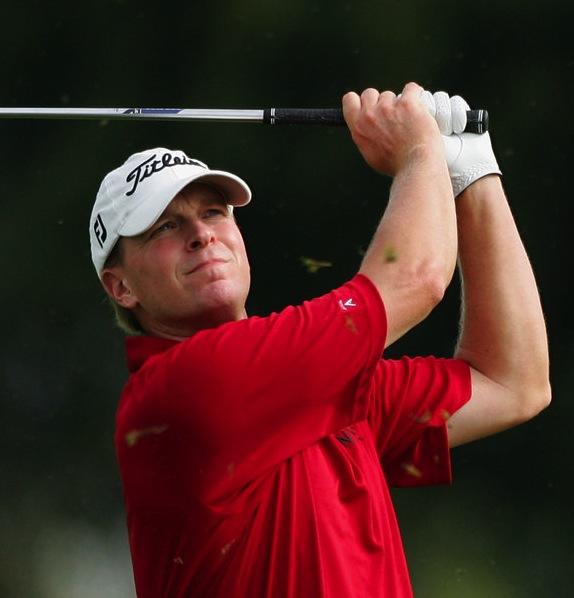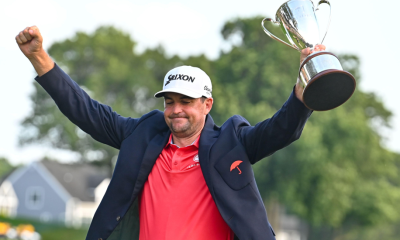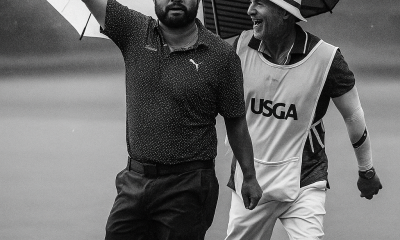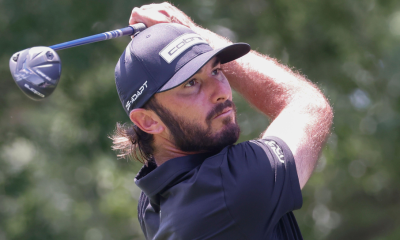Opinion & Analysis
The blind spot of PGA Tour players: Long-iron play

With the PGA Tour’s season winding down to the final tournament of the year, there will be a faction of golfers fighting to make the top 125 on the Money List in order to keep their Tour Card for 2013. I have personally worked with a few PGA Tour players, their caddies and instructors on understanding the game from a statistical standpoint.
When I started the 2012 season working with these clients there were a couple of parts of our initial interaction that surprised me:
1) Each player had made it their goal to be ‘one of the best wedge players on Tour.’
2) Each client initially did not buy into me telling them that in the grand scheme of things, full shot wedge play is not overly important. Particularly on the PGA Tour.
With the PGA Tour’s ShotLink data, the numbers are on display for statisticians like me to decipher the level of importance of each part of the game of golf. It’s very similar to the movie Moneyball and the approach Oakland A’s General Manager, Billy Beane, utilized to build his team based on the cold, hard numbers instead of traditional baseball axioms. But even better, there are far less “moving parts” in the game of golf, making the numbers more distinct and easier to see the correlation to success on Tour.
Despite that, there is still plenty of resistance to approaching the game of golf from a metrics standpoint and every year there are about 75 full time PGA Tour golfers wondering where their entire season went wrong.
***
My development into metrics and the game of golf actually started back when I was only five years old. I immediately took to the game of baseball and each week my dad would go to the local store and grab a few packs of baseball cards and give them to me where I would collect them. Eventually I would spend my entire time reading and studying each card. One of the fascinating parts of baseball is the amount of record keeping of statistics the sport has, dating back to the 19th century.
One of my favorite all-time baseball managers was Billy Martin as he would keep some data on how well certain batters performed against certain pitchers. In fact, in the 1977 American League Championship Series, Martin benched superstar Reggie Jackson because Kansas City’s starting pitcher was Paul Splittorff, who had owned Jackson each time they faced each other. Almost every baseball expert thought Martin was insane, but in the end the Yankees won the game 5-3 and went on to beat the Dodgers to win the World Series.
For better or for worse, statistics lends way to contrarian type of thinking. But if analyzed diligently and with an open mind, it can uncover truths that have eluded even the greatest experts for centuries.
In my own personal journey of golf, I had never understood what the golf term “scoring” exactly meant. Often times, hearing the words “I scored well’ left me with more questions than answers. Generally I would hear it referred to putting and chipping well, but I had plenty of rounds where I shot a low score and did not putt or chip all that well. In fact, one of my lowest rounds ever (64) came with a 4-putt.
With that, I decided to look into the ShotLink data and use my background in statistics to see if I could figure out the level of importance that certain parts of the game have on the success of PGA Tour golfers. In the process, I wound up uncovering a truth that has been long ignored by countless Tour players.
***
Before I go on, the wedge game does matter in the game of golf. In fact, every part of the game matters in the game of golf. If a golfer improves his fairway bunker play, that will lower their scores over a period of time. However, if a golfer improves their putting, that will have a bigger impact on lowering their scores than if they were to just improve their fairway bunker player. Thus, a metrics based approach to golf is about determining the level of importance that certain parts of the game have and then focusing on improving the parts of the game that have the highest level of importance in order to improve a golfer’s scores.
One of my first observations was that Tour players typically do not hit the ball well from every location with every type of club in the bag. The golfers considered to be top tier ballstrikers are usually good off the tee and then excel with certain irons like the mid-irons or the long irons or with their wedges. But to find a golfer who can hit it well off the tee and hit it well with each iron is quite rare.
I ended up splitting the game in different categories like Driving Effectiveness, Putts Gained and Short Game Play. But for the approach shots, I split them into the following categories:
- Birdie Zone Play (shots from 75-125 yards)
- Safe Zone Play (shots from 125-175 yards)
- Danger Zone Play (shots from 175-225 yards)
What I uncovered was that Danger Zone Play has the strongest correlation to success on Tour than ANY other part of the game, including putting and driving effectiveness. And it has a far stronger correlation to success on Tour than Safe Zone Play and Birdie Zone Play. Despite that, these clients of mine on the PGA Tour would tell me how important it was for them to be one of the best wedge players on Tour.
While I was a little frustrated with their desires to be the best at a part of the game that was relatively unimportant to their success, I did understand where they were coming from. I had to remember that before I did this statistical research, I had the same ideas of good Tour players would almost always get up-and-in on any shot from inside 100 yards. And if a Tour player was unable to execute from that distance, they would not find themselves on Tour for very long. This led me to wondering where this faulty thinking came from.
***
Currently, the leader in Birdie Zone play is Steve Stricker, who has hit his Birdie Zone shots an average of 15.74 feet to the cup. The average Tour player from the Birdie Zone has hit his shots 20.35 feet to the cup.
The general misconception for golfers, including actual PGA Tour golfers, is that once a good Tour player gets a wedge in their hands they will hit it close and have a tap in putt. But as the data shows, that is far from the reality. The best player from 75-125 yards is averaging almost 16 feet left to the cup on shots from this range. The average Tour player is leaving it over 20 feet to the cup.
Furthermore, the Tour average putts made percentage from 15-20 feet is only 18.3 percent. From 20-25 feet the average make percentage on Tour is 11.7 percent. Therefore, Tour players are not having a lot of tap-ins when they get a full swing wedge in their hand, but also their odds of getting up-and-in with a full swing wedge in their hands are slim at best.
Still, we need to see what the correlation between Birdie Zone Play and success on Tour actually. To give a better idea, take a look at the top-10 Birdie Zone players in 2012 and their ranking on the Money List:
Here’s a list of the players in the bottom-10 of Birdie Zone Play and their Money Ranking:
Out of the players in both lists, the bottom-10 in the Birdie Zone actually have 6 players in the top-100 on the Money List versus the top-10 Birdie Zone players which only has 5 players in the top-100 on the Money List.
Let’s compare that to the best and the worst of the Danger Zone golfers. Here is the top-10 Danger Zone golfers and their rankings on the Money List:
Here’s the bottom-10 in Danger Zone play:
Every single player in the top-10 in the Danger Zone will be in the top-125 on the Money List in 2012, regardless of what happens at Disney. But even better, those who have finished in the top-10 in the Danger Zone have had resounding success on Tour this year. Whereas four of the top-10 Birdie Zone golfers (Mulroy, Taylor, Thatcher and O’Hern) will likely have to win at Disney in order to finish in the top-125 on the Money List.
This is the blind spot for many PGA Tour players. They keep working doggedly on their wedge game whereas if they used their efforts towards the longer irons and hybrids, they would almost assuredly keep their card and get closer to nirvana, winning a PGA Tour event.
I think the cause of the ‘blind spot’ is television. Television producers are far more interested in shots that wind up close to the pin than the shots that actually have a greater impact of a golfer separating themselves from the rest of the field. That is why we see so much putting on televised rounds, those are the shots that golfers are most likely to make. When it comes to full swing shots, golfers are more likely to hit a wedge shot closer to the pin. And to make it even more visually appealing, wedge shots are more likely to get backspin as well.
Thus, the perception is that Tour players stick every wedge shot and get up-and-in with ease. That is what we usually see every week on TV. The reality is far different and that the more spectacular shot happens when a golfer hits a 190 yard shot to 15-feet with no back spin. But television ratings always take precedent over mundane facts.
Opinion & Analysis
The 2 primary challenges golf equipment companies face

As the editor-in-chief of this website and an observer of the GolfWRX forums and other online golf equipment discourse for over a decade, I’m pretty well attuned to the grunts and grumbles of a significant portion of the golf equipment purchasing spectrum. And before you accuse me of lording above all in some digital ivory tower, I’d like to offer that I worked at golf courses (public and private) for years prior to picking up my pen, so I’m well-versed in the non-degenerate golf equipment consumers out there. I touched (green)grass (retail)!
Complaints about the ills of and related to the OEMs usually follow some version of: Product cycles are too short for real innovation, tour equipment isn’t the same as retail (which is largely not true, by the way), too much is invested in marketing and not enough in R&D, top staffer X hasn’t even put the new driver in play, so it’s obviously not superior to the previous generation, prices are too high, and on and on.
Without digging into the merits of any of these claims, which I believe are mostly red herrings, I’d like to bring into view of our rangefinder what I believe to be the two primary difficulties golf equipment companies face.
One: As Terry Koehler, back when he was the CEO of Ben Hogan, told me at the time of the Ft Worth irons launch, if you can’t regularly hit the golf ball in a coin-sized area in the middle of the face, there’s not a ton that iron technology can do for you. Now, this is less true now with respect to irons than when he said it, and is less and less true by degrees as the clubs get larger (utilities, fairways, hybrids, drivers), but there remains a great deal of golf equipment truth in that statement. Think about it — which is to say, in TL;DR fashion, get lessons from a qualified instructor who will teach you about the fundamentals of repeatable impact and how the golf swing works, not just offer band-aid fixes. If you can’t repeatably deliver the golf club to the golf ball in something resembling the manner it was designed for, how can you expect to be getting the most out of the club — put another way, the maximum value from your investment?
Similarly, game improvement equipment can only improve your game if you game it. In other words, get fit for the clubs you ought to be playing rather than filling the bag with the ones you wish you could hit or used to be able to hit. Of course, don’t do this if you don’t care about performance and just want to hit a forged blade while playing off an 18 handicap. That’s absolutely fine. There were plenty of members in clubs back in the day playing Hogan Apex or Mizuno MP-32 irons who had no business doing so from a ballstriking standpoint, but they enjoyed their look, feel, and complementary qualities to their Gatsby hats and cashmere sweaters. Do what brings you a measure of joy in this maddening game.
Now, the second issue. This is not a plea for non-conforming equipment; rather, it is a statement of fact. USGA/R&A limits on every facet of golf equipment are detrimental to golf equipment manufacturers. Sure, you know this, but do you think about it as it applies to almost every element of equipment? A 500cc driver would be inherently more forgiving than a 460cc, as one with a COR measurement in excess of 0.83. 50-inch shafts. Box grooves. And on and on.
Would fewer regulations be objectively bad for the game? Would this erode its soul? Fortunately, that’s beside the point of this exercise, which is merely to point out the facts. The fact, in this case, is that equipment restrictions and regulations are the slaughterbench of an abundance of innovation in the golf equipment space. Is this for the best? Well, now I’ve asked the question twice and might as well give a partial response, I guess my answer to that would be, “It depends on what type of golf you’re playing and who you’re playing it with.”
For my part, I don’t mind embarrassing myself with vintage blades and persimmons chasing after the quasi-spiritual elevation of a well-struck shot, but that’s just me. Plenty of folks don’t give a damn if their grooves are conforming. Plenty of folks think the folks in Liberty Corner ought to add a prison to the museum for such offences. And those are just a few of the considerations for the amateur game — which doesn’t get inside the gallery ropes of the pro game…
Different strokes in the game of golf, in my humble opinion.
Anyway, I believe equipment company engineers are genuinely trying to build better equipment year over year. The marketing departments are trying to find ways to make this equipment appeal to the broadest segment of the golf market possible. All of this against (1) the backdrop of — at least for now — firm product cycles. And golfers who, with their ~15 average handicap (men), for the most part, are not striping the golf ball like Tiger in his prime and seem to have less and less time year over year to practice and improve. (2) Regulations that massively restrict what they’re able to do…
That’s the landscape as I see it and the real headwinds for golf equipment companies. No doubt, there’s more I haven’t considered, but I think the previous is a better — and better faith — point of departure when formulating any serious commentary on the golf equipment world than some of the more cynical and conspiratorial takes I hear.
Agree? Disagree? Think I’m worthy of an Adam Hadwin-esque security guard tackle? Let me know in the comments.
@golfoncbs The infamous Adam Hadwin tackle ? #golf #fyp #canada #pgatour #adamhadwin ? Ghibli-style nostalgic waltz – MaSssuguMusic
Podcasts
Fore Love of Golf: Introducing a new club concept

Episode #16 brings us Cliff McKinney. Cliff is the founder of Old Charlie Golf Club, a new club, and concept, to be built in the Florida panhandle. The model is quite interesting and aims to make great, private golf more affordable. We hope you enjoy the show!
Opinion & Analysis
On Scottie Scheffler wondering ‘What’s the point of winning?’

Last week, I came across a reel from BBC Sport on Instagram featuring Scottie Scheffler speaking to the media ahead of The Open at Royal Portrush. In it, he shared that he often wonders what the point is of wanting to win tournaments so badly — especially when he knows, deep down, that it doesn’t lead to a truly fulfilling life.
View this post on Instagram
“Is it great to be able to win tournaments and to accomplish the things I have in the game of golf? Yeah, it brings tears to my eyes just to think about it because I’ve literally worked my entire life to be good at this sport,” Scheffler said. “To have that kind of sense of accomplishment, I think, is a pretty cool feeling. To get to live out your dreams is very special, but at the end of the day, I’m not out here to inspire the next generation of golfers. I’m not out here to inspire someone to be the best player in the world, because what’s the point?”
Ironically — or perhaps perfectly — he went on to win the claret jug.
That question — what’s the point of winning? — cuts straight to the heart of the human journey.
As someone who’s spent over two decades in the trenches of professional golf, and in deep study of the mental, emotional, and spiritual dimensions of the game, I see Scottie’s inner conflict as a sign of soul evolution in motion.
I came to golf late. I wasn’t a junior standout or college All-American. At 27, I left a steady corporate job to see if I could be on the PGA Tour starting as a 14-handicap, average-length hitter. Over the years, my journey has been defined less by trophies and more by the relentless effort to navigate the deeply inequitable and gated system of professional golf — an effort that ultimately turned inward and helped me evolve as both a golfer and a person.
One perspective that helped me make sense of this inner dissonance around competition and our culture’s tendency to overvalue winning is the idea of soul evolution.
The University of Virginia’s Division of Perceptual Studies has done extensive research on reincarnation, and Netflix’s Surviving Death (Episode 6) explores the topic, too. Whether you take it literally or metaphorically, the idea that we’re on a long arc of growth — from beginner to sage elder — offers a profound perspective.
If you accept the premise literally, then terms like “young soul” and “old soul” start to hold meaning. However, even if we set the word “soul” aside, it’s easy to see that different levels of life experience produce different worldviews.
Newer souls — or people in earlier stages of their development — may be curious and kind but still lack discernment or depth. There is a naivety, and they don’t yet question as deeply, tending to see things in black and white, partly because certainty feels safer than confronting the unknown.
As we gain more experience, we begin to experiment. We test limits. We chase extreme external goals — sometimes at the expense of health, relationships, or inner peace — still operating from hunger, ambition, and the fragility of the ego.
It’s a necessary stage, but often a turbulent and unfulfilling one.
David Duval fell off the map after reaching World No. 1. Bubba Watson had his own “Is this it?” moment with his caddie, Ted Scott, after winning the Masters.
In Aaron Rodgers: Enigma, reflecting on his 2011 Super Bowl win, Rodgers said:
“Now I’ve accomplished the only thing that I really, really wanted to do in my life. Now what? I was like, ‘Did I aim at the wrong thing? Did I spend too much time thinking about stuff that ultimately doesn’t give you true happiness?’”
Jim Carrey once said, “I think everybody should get rich and famous and do everything they ever dreamed of so they can see that it’s not the answer.”
Eventually, though, something shifts.
We begin to see in shades of gray. Winning, dominating, accumulating—these pursuits lose their shine. The rewards feel more fleeting. Living in a constant state of fight-or-flight makes us feel alive, yes, but not happy and joyful.
Compassion begins to replace ambition. Love, presence, and gratitude become more fulfilling than status, profits, or trophies. We crave balance over burnout. Collaboration over competition. Meaning over metrics.
Interestingly, if we zoom out, we can apply this same model to nations and cultures. Countries, like people, have a collective “soul stage” made up of the individuals within them.
Take the United States, for example. I’d place it as a mid-level soul: highly competitive and deeply driven, but still learning emotional maturity. Still uncomfortable with nuance. Still believing that more is always better. Despite its global wins, the U.S. currently ranks just 23rd in happiness (as of 2025). You might liken it to a gifted teenager—bold, eager, and ambitious, but angsty and still figuring out how to live well and in balance. As much as a parent wants to protect their child, sometimes the child has to make their own mistakes to truly grow.
So when Scottie Scheffler wonders what the point of winning is, I don’t see someone losing strength.
I see someone evolving.
He’s beginning to look beyond the leaderboard. Beyond metrics of success that carry a lower vibration. And yet, in a poetic twist, Scheffler did go on to win The Open. But that only reinforces the point: even at the pinnacle, the question remains. And if more of us in the golf and sports world — and in U.S. culture at large — started asking similar questions, we might discover that the more meaningful trophy isn’t about accumulating or beating others at all costs.
It’s about awakening and evolving to something more than winning could ever promise.


























Louis
Aug 10, 2014 at 5:25 am
You say a player who averages 15 feet from 100 yards has a slim chance of making birdie because tour pros only make 20% of their 15 footers. How about all the shots that land inside 15 feet though?
If you hit 30 shots and average 15 feet from 100 yards it means you will have 4 putts inside of 4 feet (let’s say you make 4), 6 from 5-10 (let’s say you make 3), 5 from 11-15 (let’s say you make 2), and 15 from 15-30 (let’s assume you make 2). That gives you a better than 33% chance of making birdie.
Winning tournaments comes from making birdies and not screwing up badly. Going from a 7% margin of error to 5% margin of error with long irons isn’t gonna make you score any better.
Not spraying your long irons will help immensely. Because that’s a really easy place to lose strokes.
Lesson: keep the ball in play (hit greens) with your long irons. That’s it. Don’t worry about being better than able to hit it within 50 feet of where you aim consistently (still hard to do). Going from 50 feet to 40 feet won’t help.
Eliminate inconsistencies that produce big misses.
Once you have that down, to score well, hitting the wedges closer is the easiest way.
Sam
Jun 18, 2013 at 5:33 am
Interesting stuff, here’s my 2cents worth…
PGA Tour players are just like other golfers, they follow trends. In the 90’s everyone on Tour jumped on the 52, 56, 60 bandwagon with Tom Kite, when he took distance control to a new level. Then along came Tiger with 48, 54, 58 and they all dumped a wedge. Lately, club lofts have changed the make up of sets, making 3 iron redundant in many cases (as shown above). The reason the DZ looks more important to scoring than the BZ is that relative to the other parts of their game the average PGA Tour Pro is poor in the BZ. The reason for this is simple: not enough tools to do the job. Modern PW clubs have become much stronger, instead of keeping the loft/distance gaps even, everyone followed Tiger and minimized the short end of their set. No doubt, more options and more full shot yardages will result in closer to the hole with wedges, it would be interesting to look at the correlation between number of scoring clubs and proximity to the hole, pretty sure you will find that guys with 3-4 wedges get it closer more often than the two club guys. Now that’s a blind spot!
JD
Nov 13, 2013 at 5:15 am
Interesting comment. But what I think you have failed to recognise is the fact PGA tour courses have become much longer and therefore require more clubs down the long end of the set make up. As a professional caddie and also a pro myself I have seen this first hand. There are also more courses with par 3 holes that are between 200-225 yards, couple that with longer par 4 holes that require longer, higher and softer shots players are forced into a hybrid as well as 3 irons. This is one reason I feel players are dumping the extra edge.
Mike
Feb 21, 2013 at 10:11 pm
The article is interesting but I am not sure that using Money List as a correlation to Birdie/Danger Zone is a statistically sound method. The Money List is a total of earnings but that is subject to a variable you have not accounted for which is the number of starts a player has on the Tour. Even an average PGA Tour player will have more money when they have more starts. A better comparison of earnings to player performance statistics would at least use “earnings per start” to eliminate the variable related to the number of starts.
Also, isn’t there some relationship between BZ, SZ and DZ that you have not accounted for? For example, Steve Stricker rates Top 10 in BZ and DZ efficiency and Adam Scott is 189th in BZ and obviously not Top 10 in DZ. One would think, based on the analysis, that Adam Scott would finish far below Steve Stricker yet the opposite is true. Scott (16 starts) actually finished with slightly higher earnings per start ($181,000) than did Stricker (19 starts and $180,000 per start).
Alex
Feb 14, 2013 at 2:40 pm
First of all great article…
Last year i actually kept record of 30 rounds and analyzed them through out. I took lowest 10 rounds and see what i did best during those rounds. This is what i found. 7 out of 10 rounds i hit 12 fairways each of those rounds, however also note i took more 3 woods and hybrids off the tee that left me a lot of 150-185 yard approaches. In those rounds i hit about 14 greens on avg. What this concluded for me is that i am a lot better hitting 7,6,5 and hybrids off the fairway than wedges from the rough. I am pretty decent putter and will not really 3 putt very often, however i will also not drain too many 20 footers for birdies. If Tour avg from the BZ is about 20 ft then i will be definitely over that, so as an amateur if i want to score better but more importantly consistently better i should be hitting 3/5 woods off the tees and hitting 7 irons into greens taking my 2 putts and going to the next hole. This is where this article is dead on, for me to get better either i need to drive better and be on the short grass with my driver leaving wedges in or improve my approaches from 150-185. Now what is easier to improve….
Jeff
Feb 14, 2013 at 12:00 pm
Great article, really can relate to this.
Dane
Feb 13, 2013 at 2:01 pm
Great article Mark. Being a golf professional this has put into writing what plenty of golf pros think. I will definitely look more into your work!
Philip
Feb 8, 2013 at 11:30 am
Wow! I think I need to become a statistician to analyze my golf game! Call me weird, but these are fun articles!
mark burk
Nov 5, 2012 at 9:28 am
All of the players you metion are good danger zone players are longer hitters and bad dangerzone players are short hitters. 175 to 225 for the good ones mention are mostly mid irons that can hold the firm pga tour greens, they also will be able to hit par 5’s in two more often which is where these guys make there birdies with shorter clubs and since most the par 3’s on tour are over 200 yards plays to the advantage of the longer hitters. So it would be better most of the world class player have good long game because of distance. If you want to talk about where weekend warrior can save shots it is with the shortgame. If a player can eliminate 3 putts and get up and down more often it will save them more strokes than being a good iron player from 175 to 225. Keeping the ball in play, eliminating 3 putts and decent short game will keep the score down for the average weekend golfer. Every time I go to range at my club the chipping and putting green are empty and the range is full. What will lower a score faster going from 38 putts a round to 30 or hitting good long iron or hybrid shots which will maybe be hit 4 times a round. This is for the weekend player
Richie Hunt
Nov 7, 2012 at 9:54 am
Mark,
I only showed the top-10 and bottom-10, but there is no substantative statistical correlation between distance off the tee or clubhead speed or a combination of the two and DZ play. And I have ran these numbers since 2003 for Distance and DZ play and thru 2007 for clubhead speed and DZ play.
There are plenty of examples of shorter hitting, low clubhead speed players that play great from the DZ each year. McDowell is ranked 8th in the DZ and not very long. Same with Stricker. Furyk is ranked 12th and routinely does great in the DZ. Same for other shorter hitters like David Toms (who was ranked #1 in 2011), Heath Slocum, and Zach Johnson.
Meanwhile there are longer hitters that struggle from the DZ. Like Chopra, Driscoll, Lamely, and Mark Anderson (currently ranked 174th) and Jhonattan Vegas (currently ranked 175th).
Distance helps…slightly. But it’s not enough help for Tour players to overcome a lack of skill in the Danger Zone.
Brett Adamkiewicz
Nov 1, 2012 at 11:03 am
What a well rounded article, and explained better than I have ever heard it. I have always taken a different thought process compared to the average joe. Not to exaggerate but we have all heard the phrase “drive for show and putt for dough” a million times. Fact of the matter is you will never win any “dough” if your superb putting skills are saving bogey and double bogeys all the time. On a side topic I am curious as too the percentage of penalty strokes taken in a round are due to tee shots and the “danger zone” shots. I know the phrase doesn’t exactly fit with the danger zone but it is all relative. 175 and out is what I call my scoring zone. I can have a bad putting and chipping day and still be sub 80. If I can’t get off the tee and can’t get around the green, the limit on my score…. I am taking a trip with 7 of my buddies to Kiawah Island this weekend and I am going to put this to the test! Most of them are all mid to low handicappers and can play well! I am going to have a little fun with this and track their scoring relative to your “Danger Zone” and off the tee. Thank you for this article and I hope more people will read this and pay attention.
Brett Adamkiewicz
Nov 1, 2012 at 11:05 am
The sky is the limit on my score. Left out that part.
Dan
Oct 31, 2012 at 8:12 pm
Fantastic article, very insightful. It will be great to stop focusing on the “Glamorous” parts of the game and focus more on the shots that lower my score.
DaleH
Oct 31, 2012 at 5:02 pm
Exactly.. most amatures do struggle with the short game but really struggle with longer irons like myself. I’m usually on hitting into greens with say an 8 iron or less, 7-4 not as good, the longer the iron the the less my chances. Time to practice more on the long irons. Thanks for the facts.
Pingback: GolfWRX.com – The blind spot of PGA Tour players: Long-iron play | Golf Products Reviews